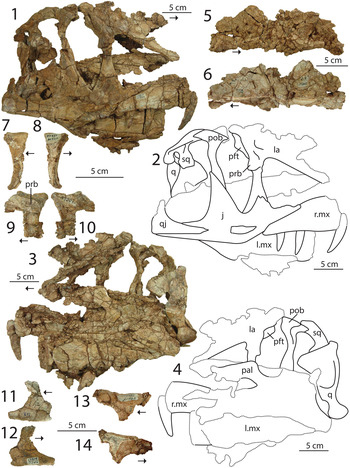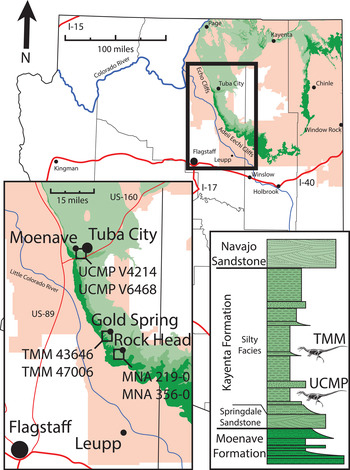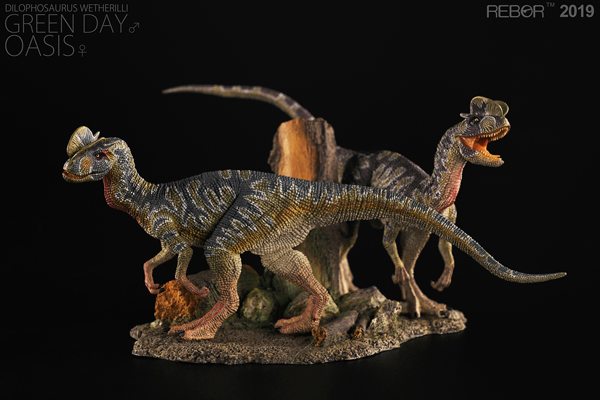Comprehensive Review of Dilophosaurus – Paints New Picture of Predator
Researchers from the University of Texas at Austin and the Petrified Forest National Park have published a comprehensive review of Dilophosaurus wetherilli fossil material and revealed that “double-crested lizard” had stronger jaws than previously thought. Those famous skull crests turn out to be more robust as well. Instead of being regarded as a delicately-jawed scavenger, this iconic dinosaur from the Early Jurassic of North America may have been an apex predator.
Previously Thought to be Quite Lightly Built with Delicate Jaws

Picture credit: Everything Dinosaur
Not a Member of the Ceratosauria Clade?
Writing in the “Journal of Palaeontology”, researchers Adam Marsh (University of Texas Austin) and Timothy Rowe (Division of Resource Management, Petrified Forest National Park, Arizona), conducted an extensive review and re-examination of all the know specimens of Dilophosaurus wetherilli and concluded that this large-bodied theropod was probably not a member of the Ceratosauria or indeed, the Coelophysoidea, but was a stem-averostran theropod, a member of the Averostra clade. As such, D. wetherilli shows a phylogenetic relationship with Cryolophosaurus ellioti which is known from the Early Jurassic of Antarctica and Zupaysaurus rougieri, fossils of which come from the Late Triassic of Argentina.
The Review Included A Reassessment of the Holotype Skull Material

Picture credit: Marsh et al (Journal of Palaeontology)
Dilophosaurus wetherilli
With an estimated body length of around six metres, D. wetherilli is one of the largest terrestrial predators known from the Early Jurassic of North America. Despite extensive study of the fossil material and this dinosaur’s on-going popularity with the public due to its depiction as a venom-spitting, frilled dinosaur in the first “Jurassic Park” film released in 1993, much of the animal’s skeleton, anatomy, ontogeny and taxonomic relationship with other members of the Theropoda remains unknown.
Using fossils collected from the middle and lower portions of the Kayenta Formation (Navajo Nation, northern Arizona), the scientists comprehensively reviewed the holotype cranial material (UCMP 37302). In addition, previously undescribed specimens were analysed and it was concluded that the fossils represent a single species, a large, crested theropod within the Kayenta Formation. This suggests that Dilophosaurus, as a species, persisted for a long time – several million years.
Dilophosaurus Fossil Finds in the Navajo Nation

Picture credit: Marsh et al (Journal of Palaeontology)
It is noted that many anatomical characteristics of the skeleton are more derived when compared to Late Triassic theropods, adaptations to a larger body size and a more robust macropredatory habit.
An Articulated Hindlimb Assigned to D. wetherilli
Picture credit: Marsh et al (Journal of Palaeontology)
Dilophosaurus an Apex Predator
Previous research had suggested that Dilophosaurus had weak jaws and this may have influenced how this dinosaur was depicted in the “Jurassic Park” franchise. This review identified areas of attachment for powerful jaw muscles and that the skeleton was pneumatised (air pockets) and these structures would have helped to both lighten and strengthen the skull. The authors state that whilst Dilophosaurus could catch small animals and even catch fish in the fluvial environment with which its fossils are associated, the robust upper jaw and strong grasping hands suggest that it was equipped to tackle far larger prey.
The idea of Dilophosaurus being a much more powerful and dangerous animal is supported by the discovery of partially articulated specimens of the early sauropodomorph Sarahsaurus (S. aurifontanalis) containing large bite marks alongside shed teeth and a skeleton of Dilophosaurus wetherilli within the same quarry as reported by Rowe et al in 2011.
A Dilophosaurus Braincase
During the comprehensive review, the researchers were able to assign to the Dilophosaurus genus a number of other specimens that had come from the Kayenta Formation, including a remarkably-well preserved small braincase from a juvenile.
Commenting on their fortuitous find Dr Marsh stated:
“In the midst of the analysis, we discovered that a small braincase in the Jackson School’s collections belonged to a Dilophosaurus wetherilli. We realised that it wasn’t a new type of dinosaur, but a juvenile Dilophosaurus wetherilli, which is really cool.”
The More Robust Rebor Figures Introduced in 2019 May Represent a More Accurate Depiction of Dilophosaurus wetherilli

Picture credit: Everything Dinosaur
The picture (above) shows the Rebor Dilophosaurus figures.
To view the Rebor range of models: Rebor Dinosaur and Animal Models.
The strong jaws coupled with the powerful forelimbs suggests that Dilophosaurus was an active predator rather than a scavenger. It seems that many palaeontologists perceptions regarding Dilophosaurus wetherilli will have to be reconsidered, science as well as the film industry might have got this dinosaur all wrong.
The scientific paper: “A comprehensive anatomical and phylogenetic evaluation of Dilophosaurus wetherilli (Dinosauria, Theropoda) with descriptions of new specimens from the Kayenta Formation of northern Arizona” by Adam D. Marsh and Timothy B. Rowe published in the Journal of Palaeontology.
The Everything Dinosaur: The Everything Dinosaur Website.







Leave A Comment